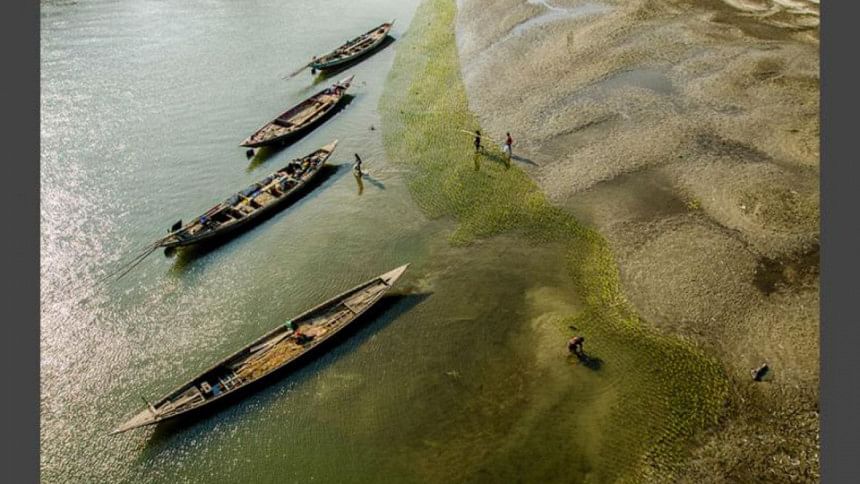The crisis of fresh water

In his famous poem "The Rime of the Ancient Mariner", the 18th-century English poet Samuel Taylor Coleridge eloquently reflects on the scarcity of water in the sea: "Water, water everywhere, nor any drop to drink". This line may be applicable to present-day Bangladesh where, during the monsoon season, the country gets flooded and fresh water (non-salted water) becomes scarce.
It may be noted that the history of "Golden Bengal" would not be complete without its rivers. Experts estimate that over 700 rivers crisscross the country (reportedly Chittagong district alone has 78 rivers including the Karnaphuli). The Ganges-Jamuna-Meghna deltaic estuary is the second largest in the world, after the Amazon basin in Brazil. The land, river and people of this region have played their part to make the country prosper. With the flows of the rivers, riverside markets had multiplied, immensely benefitting the farmers and the people in general although of late, thanks to declining water flow in many of the rivers, the situation has changed.
All rivers in Bangladesh originate from the Himalayan mountains and almost all rivers flow though India. It is reported that about 54 rivers flow to Bangladesh from India, and thus sharing of river waters is a necessity. Unfortunately, out of the 54 rivers, Bangladesh has been able to sign a water-sharing agreement for only one, the Ganges, for a period of 30 years. India, being an upper riparian country, reportedly diverts water from transboundary rivers by building artificial structures on them, controlling their flow to the disadvantage of Bangladesh.
Another factor is that Bangladesh is adversely affected during the monsoon season, when India opens the gates of the Farakka Barrage which is located about 10 kilometres from the border. This causes severe flooding in Bangladesh leading to erosion of the banks of rivers with deposits of silt.
Deposit of silt is another problem for riverbeds. It is estimated that 1.2 billion of silt is dumped on the bed of the rivers. As a result, it is reported that during the dry season, about 50 million people in the south-west region of the country, and the Sundarbans forest area, have been adversely affected. This, some say, may lead the forest to its potential extinction in the future.
One of the mighty rivers, the Ganges, known in Bangladesh as Padma, has been dying and as a result, an offshoot of the Padma, the river Gorai, which flows in the southwest in the country, is reportedly almost dead due to heavy siltation and formation of deep strip of big sandy land (char).
The rivers in Bangladesh which play a key part in the transportation of passengers and cargoes face serious problems following the formation of sandbar (char) and shoals of the rivers. The river transport system involving both rivers and big canals, once so popular in the country, rarely exists now because of the siltation of the riverbeds. Furthermore, the rivers in the southwest face salinity problems. Salinity has been a serious threat to agriculture, fishery, livestock, forestry, sanitation and environment. Padma was once famous for the supply of the "king" of fish, Hilsa, but it's not as readily available today. It is said that the Hilsa fish from Padma is much tastier than that found in West Bengal. I was often reminded of this when I was posted in Calcutta in the early 80s.
The scarcity of Hilsa forced many fishermen to give up their ancestral profession and many communities such as potters, weavers, and oil-makers who used to live along the river banks have been reduced to a negligible number at present. Furthermore, the heavy and continuous river erosion has destroyed hundreds of villages, thus leaving poor people homeless. Many cultural activities that revolved around the existence of river and water, such as boat-racing and other festivals, are fast disappearing. Moreover, the folk singers and Jatras and other traditional performing arts have also been affected.
Modernisation has also seriously affected people's way of life. Modern technology has replaced the traditional practices. Insecticide and chemical fertilisers have destroyed many insects which were helpful to agriculture. Fish has been affected by the use of such chemicals and in many places, availability of fish is very limited. Furthermore, many birds, frogs, other aquatic animals and creatures are rarely seen.
Another problem that has arisen out of the use of chemicals is the contamination of tube-well water with arsenic, which has rendered rural folks unable to use it. People who used to use water—both surface and underground—for irrigation are now facing great difficulties because of water shortage.
Bangladesh, being a lower riparian country, faces fresh-water crisis because of the rapid retreat of the Himalayan glaciers, increasing effects of climate change, deterioration of river of ecology and the construction of houses and other structures for the growing population (over three thousand people per square mile on average), which have all impacted the flow of fresh water.
The history of water-sharing conflicts in South Asia is a troubling one. The conflicts arise because sharing of water is not equitable and does not meet the needs of the countries involved. Moreover, India is believed to be installing artificial structures to divert water from the rivers (both the Ganges and Brahmaputra) to the detriment of Bangladesh.
All these factors lead to a bleak scenario. There is a possibility that Bangladesh, a land of six seasons, may turn into a barren land due to the scarcity of fresh water, and whatever greenery the country still has may not exist in the future.
Barrister Harun ur Rashid is a former Bangladesh ambassador to the UN, Geneva.





Comments